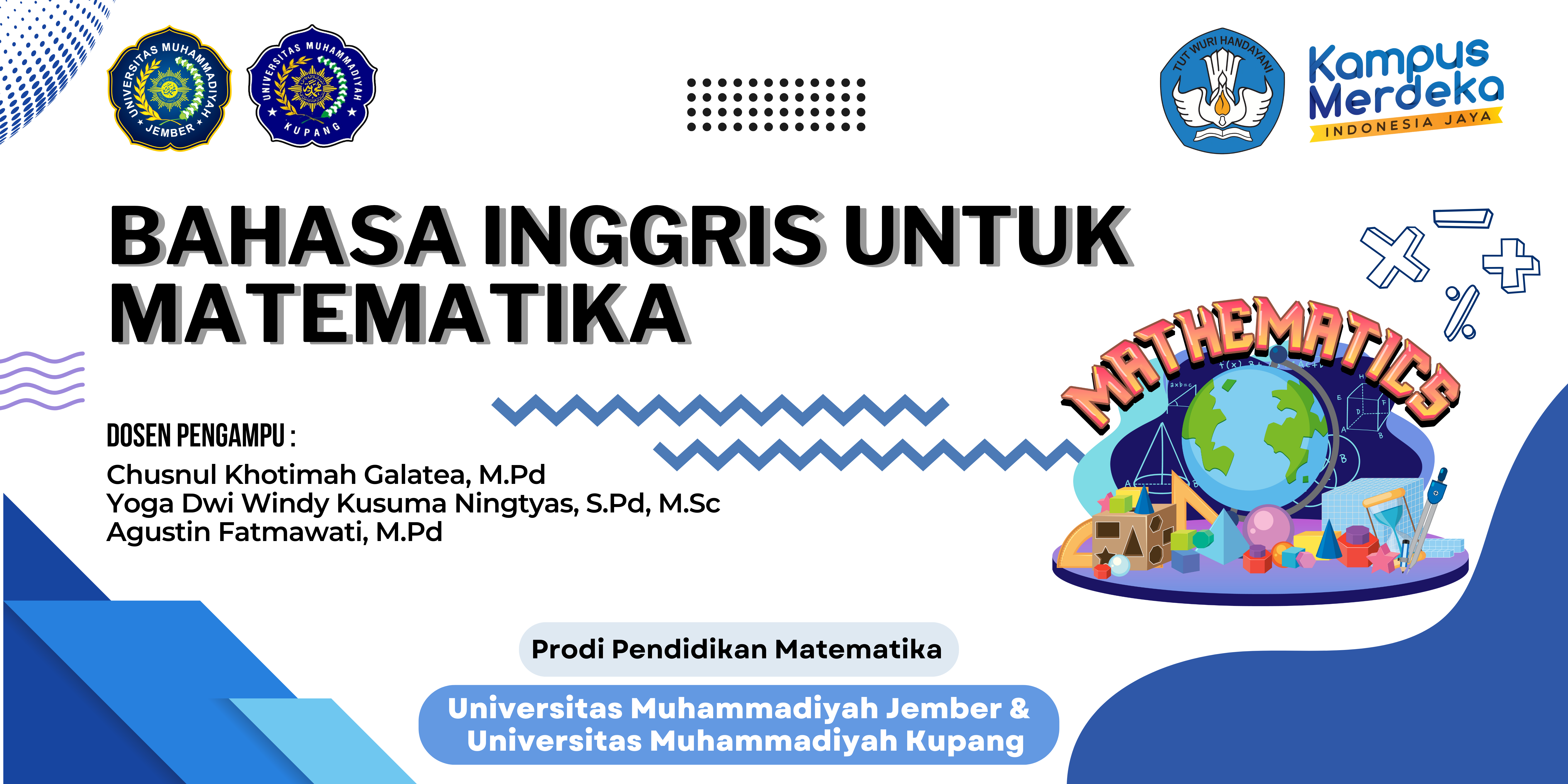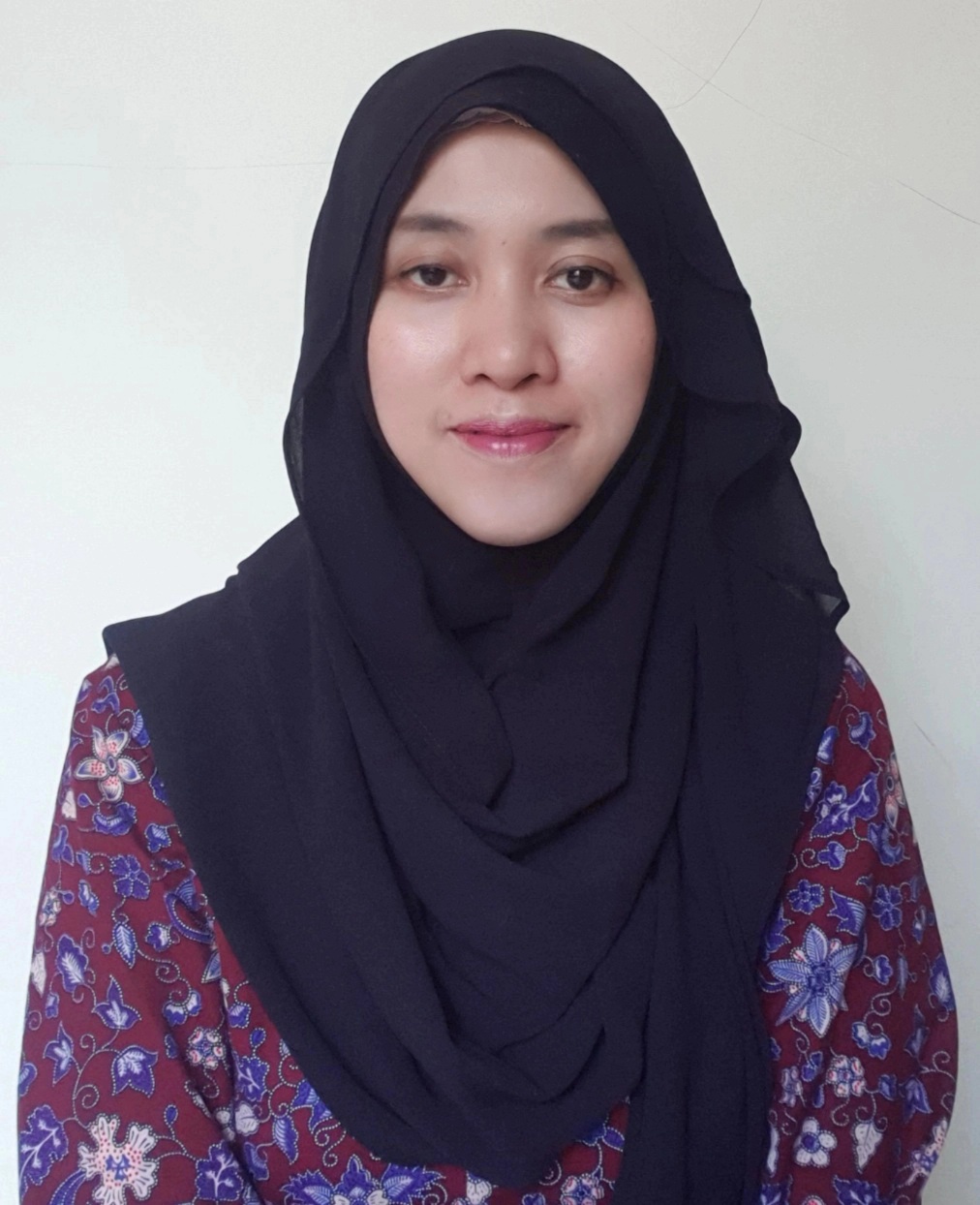Course Description

Assalamualaikum Wr. Wb.
Hey there, math enthusiasts!
Welcome to the English for Mathematics course. Get ready to embark on a journey where numbers meet language. We're thrilled to have you on board and can't wait to explore the exciting world of math in English together.
Let's make learning a blast!
Course Identity
- Course: English
- Course Code: MJU.MAT-040
- Credit Hours: 2
- Semester: Odd Semester
- Study Program: Mathematics Education
- Faculty and University: Faculty of Teacher Training and Education of Universitas Muhammadiyah Jember
Course Brief
This course covers the comprehension, pronunciation, writing, and listening of mathematical terms and concepts (numbers and their operations, algebra, equations, geometry, and trigonometry) in the English language.
Graduate Learning Outcomes
- To be devout to the One and Only God (Allah SWT) and able to demonstrate religious attitudes (A1).
- To possess Islamic character (A12).
- To be capable of applying logical, critical, systematic, and innovative thinking in the development or implementation of science and technology, considering and applying appropriate human values in their field of expertise (GS1).
- To exhibit independent, quality, and measurable performance (GS2).
- To apply concepts and pedagogical-didactic principles of mathematics and mathematical knowledge to conduct innovative learning that utilizes science and technology-oriented towards life skills (SS2).
- To master theoretical concepts of mathematics, including mathematical logic, discrete mathematics, algebra, analysis, geometry, probability and statistics theory, mathematical modeling principles, linear programming, differential equations, and numerical methods to support mathematics education in elementary and secondary schools as well as for advanced studies. (KM2).
Course Learning Outcomes (CLO)
- Able to demonstrate adherence to Islamic values (GLO-1 and GLO-2).
- Able to communicate mathematical concepts in English effectively, both orally and in writing (GLO-3).
- Capable of demonstrating independent and collaborative performance in the learning process or when completing tasks of high quality and measurability (GLO-4).
- Proficient in solving problems in English related to the field of mathematics (GLO-5).
- Mastering mathematical concepts and mathematical terminology in English (GLO-6).
Topic
- Numbers and arithmetic operations
- Algebra
- Trigonometry
- Geometry
Lesson Plan
The Learning Management System (LMS) can serve as an online classroom for interactions between instructors and students, or it can be employed as a platform for in-depth material exploration (flipped learning), or any other model of blended learning.
Assessment
- Attendance: 10%
- Participation: 15%
- Assignments/Cases: 20%
- Midterm Exam (UTS): 25%
- Final Exam (UAS)/Project: 30%
Semester Lesson Plan
Semester Learning Plan serves as a guide for course instructors in conducting semester-long teaching. It includes Learning Outcomes (LO), Course Learning Outcomes (CLO), Learning Analysis, Planned Final Competencies, Semester Lesson Plan (presented in a table with week numbers), planned final abilities, study materials, forms and learning methods, timing, student learning experiences, assessment criteria, and weight indicator indicators, Assignment Design, Midterm Exam Design, and Final Exam Design. The lesson plan can be accessed here: https://bit.ly/englishlp2023
Lecturer
 Name: Chusnul Khotimah Galatea, M.Pd.
Name: Chusnul Khotimah Galatea, M.Pd.
NIDN: 0729018802
E-mail: chusnulkhotimah@unmuhjember.ac.id
Institution: Universitas Muhammadiyah Jember

Name: Yoga Dwi Windy Kusuma Ningtyas, M.Pd., M.Sc.
NIDN: 0730038902
E-mail: kusumaningtyas.dwi@unmuhjember.ac.id.
Institution: Universitas Muhammadiyah Jember

Name: Agustin Fatmawati, M.Pd.
NIDN: 15300892001
E-mail: agustin.fatma@gmail.com
Institution: Universitas Muhammadiyah Kupang
References
- Asnawi, M. H., Annisa, H., Ulum, M. M., Arofah, N. L., & Hendrawati, N. E. (2022). Ethnomathematic Exploration at Agung Jami’Malang Mosque in Improving Students' Mathematic Problem-Solving Ability. IndoMath: Indonesia Mathematics Education, 5(1), 13-21.
- Chang, L. A., White, C. M., & Abrahamson, L. (2008). Handbook for spoken mathematics. Livermore National L.
- Kusumawardhani, R. A., Agustina, L., & Galatea, C. K. (2023). Analisis Kemampuan Numerasi Siswa dalam Materi Geometri dan Pengukuran Ditinjau Dari Gaya Kognitif Reflektif dan Impulsif. JEMS: Jurnal Edukasi Matematika dan Sains, 11(1), 107-115.
- Munthahana, J., & Budiarto, M. T. (2020). Ethnomathematics Exploration in Panataran Temple and Its Implementation in Learning. Indonesian Journal of Science and Mathematics Education, 3(2), 196-209.
- Ningtyas, Y. D. W. K., Galatea, C. K., Ishartono, N., & Adikalan, N. H. (2023). Learning Trajectory for Learning Multiplication Rules with Islamic Values using Realistic Mathematics Education Approach. Vygotsky: Jurnal Pendidikan Matematika dan Matematika, 5(2), 123-134.
- Sterling, M. J. (2023). Trigonometry for dummies. John Wiley & Sons.
- Rumsey, D. J. (2019). Statistics Workbook for Dummies with Online Practice. John Wiley & Sons.
- Ryan, M. (2015). Calculus workbook for Dummies. John Wiley & Sons.
- Ryan, M. (2006). Geometry Workbook for Dummies. John Wiley & Sons.
- Safitri, A. H. I., Novaldin, I. D., & Supiarmo, M. G. (2022). Uma Lengge Traditional Building as a Source of Ethnomathematics-Based Mathematics Learning Implementation. EDUPEDIKA: Jurnal Studi Pendidikan dan Pembelajaran, 1(1), 45-52.
- Supiyati, S., & Hanum, F. (2019). Ethnomathematics in Sasaknese Architecture. Journal on Mathematics Education, 10(1), 47-58.